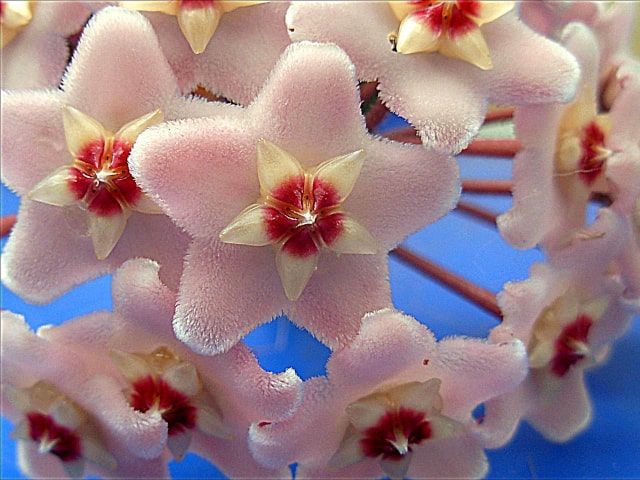
The Hoya plant is known for its thick leaves and a characteristic shape. They are climbing and clambering so they make a very interesting sight in any home. The Hoya plants are also known as "the Hindu rope" or "Wax plant". They are wax-stemmed and produce beautiful flowers. Many people like to grow them in their home, balcony or garden.
These plants have been enjoyed for decades and they are very popular among many home gardeners. The Hoys plant has wheel-like clusters of porcelain or waxy flowers. The flowers typically have stars in their crowns. The flowers often produce unique, enjoyable fragrance.
The Hoya Plant: Basic Information
This plant was named in honor of Thomas Hoym, who was a gardener for the Duke of Northumberland. Hoym was the first one who recognized the beauty and uniqueness of this plant and he brought it into prominence.
The Hoya plant is native to southern India. There, the Hoya plant is highly prized and it's even a subject of legend. These plants are also commonly found throughout eastern Asia and Australia.
The Hoya plant is botanically classified in the asclepias (milkweed) family.
There are many species of the Hoya plant but it's not clear how many of them are there exactly. According to the Bailey's Standard Cyclopedia of Horticulture, there are around 100 species of these plant. The most common species is Hoya carnosa variegata. This one is commonly grown as a houseplant.
There are also other species and varieties some people choose to grow. For example, Hoya carnosa variegata has a very striking, variable foliage. The appearance of the foliage sometimes changes as the plant matures.
Another variety, Hoya carnosa compacta, is an interesting plant. It has crumpled foliage. On the other hand, its blooms are among the most spectacular of the all Hoya plant varieties.
The Hoya plants that climb use small stem rootlets. When they are untrained they form a thick mat. Some of the species make beautiful baskets.
The Hoya plants are generally known for its foliage. The plant has thick leaves of green, rimmed with white and red. The leaves have a waxen texture, hence the name of the plant. The Hoya plants are very characteristic and beautiful so it's not surprising that so many people choose to grow it in their home.
Hoya has beautiful blooms and they are uniquely looking. They seem as if they are fashioned from ivory of porcelain, with beautiful centers made of ruby and amethyst. You will recognize this plant for its waxen ball of double, five-pointed stars. It's geometrically perfect so it almost seems artificial. Don't be surprised if some of your guests don't believe your Hoya is real until they approach it. They will be pleasantly surprised to know that yes, it's real.
Hoya Plant Care
Here are some basic tips and information on how to care for your Hoya plant.
The plant is native to tropical and subtropical regions, which influence the care you should provide. However, most Hoya plants can thrive indoors and they generally don't require much care. You should place it in protected areas or in a greenhouse. A Hoya plant can also be kept in a sunny window. The foliage can be decorative and the plant will flower in late spring or summer.
On the other hand, your Hoya plant can also thrive in a north window. It's actually a good location in a home environment. What is important to provide is enough light. Hoya plants don't require direct light but they should not be kept away from a window. The only exception is to grow your Hoya plant under fluorescent grow lights. A general rule of thumb here is to provide all but the hottest sun.
When it comes to soil requirements, Hoya thrives in a moist, light, well-drained soil. You can use African Violet soil for your Hoya plants. Just make sure to add some perlite. It's a great growing medium for these plants.
Watering should be such to allow your Hoya plant to grow in a moist soil in spring and summer. During winter, the soil should be dry, but not to the point of shriveled foliage. Keep in mind that a more frequent watering might be necessary in dry climates.
Some people choose to mist the leaves frequently. This will clean the foliage and increase humidity. This is a good thing to do, just make sure not to do it when the plant is budding or in flower.
When it comes to temperature requirements, it's best to give your Hoya plants medium (around 50 degrees) or a warm temperature during the growing season (spring and summer). The plant will go semi-dormant in winter.
Fertilizer: Your Hoya plant will benefit from some fertilizer in the spring. You should apply a liquid food about once in every four weeks. The feeding should be applied 3-4 times during the growing season. It will help the plant grow vigorously. During winter, it's best to withhold food. As pointed above, the plant is semi-dormant during that time so fertilizer is not required.
Keep in mind that the lack of water or too much fertilizer can cause the foliage to develop brown edges. In some cases. The leaves might drop.
The blooms will appear when the plant is most active, during spring and summer. Remember: you should never move or touch your Hoya plant during its blooming period. You should admire it from afar.
Just like most other plants, Hoyas respond well to good care, so you should provide it. However, it's important not to pamper them - Hoyas don't respond well to that. Resist constant hovering, handling or moving. Most of the time, your Hoya plant is best to be left alone.
Propagation
It's best to propagate your Hoya plant by cuttings of top growth. Alternatively, you may use leaf cuttings in the same way you propagate African violets or gloxinias. On average, a cutting or a leaf will produce a blooming plant in about two years (sometimes even less!)
The quickest and easiest way to propagate your Hoya plants is by layering. Layers mature faster and they don't require so much care or patience on your part. All you need to do is to pin down a stem at the joint in a moist rooting medium. When the roots have formed, sever the new plant and pot it in a new container.
Layering is great for those who want quick and good results. For example, one mature Hoya plant can give 50+ plants in less than a year using layering for propagation. For layering, it's best to use commercial African violet soil as a growing medium. Also, using clay pots and not plastic ones gives better results (though it's ok to use the plastic ones if you don't have clay pots).
You can also root your Hoya cuttings in water. It's best to use a jug filled with water for this purpose. Hoya varieties that do good when this method is used are Hoya carnosa (with plain green leaves), a variegated form of carnosa and Hoya bella (miniature).
It's theoretically possible to start a Hoya plant using seeds, but it's almost unheard of. The reason is that seeds are scarce. The blooms seldom produce seeds. The pollination is difficult so this is why this method is not common. In their native environment, the Hoya plants are pollinated by insects not known in other parts of the world (America, Europe), so this is why starting Hoyas by seeds is very uncommon.
Pests and Diseases
Hoya plants don't have many pests. Probably the worst of them all is the root-knot nematode. Since Hoya plants are not commonly grown outdoors, this problem is not really common. However, these nematodes do like Hoya plants and can "sense" it from a far, so it's something to watch out for.
In case your Hoya plant is dying from a nematode infection, the only thing you can do is to salvage leaf and stem cuttings and start a new plant from them. Make sure to destroy the roots and soil of the infected plant.
Aphids may also pose a problem, though it's rare. Aphids like the sweet juices of the Hoya plants. However, they can easily be controlled by most of the insecticide sprays or insecticidal soaps.
Mealybugs will sometimes attack a Hoya plant but they can easily be controlled in the same way Aphids are controlled. Ants often accompany aphids and red spider mites might pose a problem but they can be kept away with a malathion spray (use it periodically).
Additional Tips
Here are some additional tips that will help you care for your Hoya plant and make it thrive.
- The Hoya plants have unique blooms, which are produces on knobby spurs. These spurs should stay on the plant even after the blossoms have faded. The plant will grow new buds on these spots. In order to encourage your Hoya plant to bloom, it's best to leave those spurs on the plant even after the original blossoms have faded.
- For the best, fuller flowering, it's good for Hoya's roots to be pot-bound.
- What to do if your Hoya plant doesn't bloom? Fear not: it happens to many Hoyas grown indoors. Make sure to provide the optimal care discussed above. In order to bloom, your Hoya plant needs to thrive. A Hoya plant flourish best when kept in bring light, with ample moisture around the roots and in humid air.
- Winter care should be different than care given during a growing season. During winter, keep your plant cool (50 degrees F max) and dry. If you continue with high temperatures and fertilizing you are promoting the leaf and stem growth, which prevents the formation of the flower buds, which will prevent your Hoya from flowering in the spring.
- During winter, when you observe that the buds are set, you may increase the temperature slightly.
Most Common Hoya Species
Here is a quick list of the most common Hoya species. You can grow most of them in your home.
- Hoya australis. This species has big, waxen, deep-green leaves. They are about 4 inches across. They can be recognized easily because they are splotched with silver. This plant is a strong grower and it likes to vines. Its flowers are fragrant and very beautiful: pink with red crowns.
- Hoya bandaensis. This is a sturdy plant with glossy leaves in deep-green color.
- Hoya bella. This is a dwarf species. It doesn't grow fast but it looks very beautiful. It has slender upright branches that will droop down as they age. This is a non-climber species. The leaves are thick and dark green. Its flowers are white with purple centers. It's one of the most popular Hoya species among home gardeners.
- Hoya carnosa. This is another old-timer. It has shiny, dark green leaves. The leaves oval and pointed. This species has faint pink flowers centered with a red star-crown. It's a great climber and it climbs best by sinking its aerial roots into a porous support such as a moss pole. There ar several variations available: "Exotica", which has green leaves centered with cream (sometimes pink-tinged); Variegata, with irregularly edged leaves with creamy-white and touched with pink in sun.
- Hoya coronaria. This species is a great climber. The downside is that it's not widely available. This plant has waxy leaves that re-curve. The leaves are hairy beneath. This species produces pale, lemon-yellow flowers with red spots.
- Hoya imperialis. With this species, the stems and leaves are dusted with down and margins are curled. These plants have big, red-brown flowers with creamy centers.
- Hoya keysi. These plants have thick, close-jointed stems. The leaves are heavy, gray-green and covered with down, off-white flowers with red base.
- Hoya latifolia (cinnamonum). This species has egg-shaped, coppery leaves with pale veins.
- Hoya longifolia shepherdi (angustifolia). This plant has slender leaves intended at the center vein so they appear almost folded. The flowers are white, accented with bright wine and delicate.
- Hoya macrophylla. This is a creeping species with copper-green, light-veined leaves. The flowers are white.
- Hoya motoskei. This is a free-flowering vine and it's considered to be the true Hoya carnosa. It has elliptical leaves in lighter green color and unevenly speckled with silver. The flowers appear in clusters and they are pinkish-white, with maroon centers.
- Hoya multiflora. This is a stout, climbing plant. It has huge, leathery leaves. It's flowers are yellow. It has a distinctive variety: "Silver Leaf". This is a multiflora with dark-green leaves blotched with silvery pink. They have red stems and are hairy. The flowers are the color of vintage wine, with crowns of silver-pink stars.
Photo credit: Mo
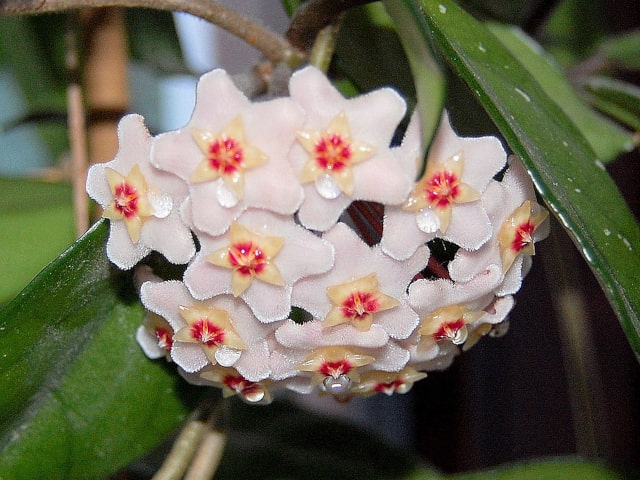
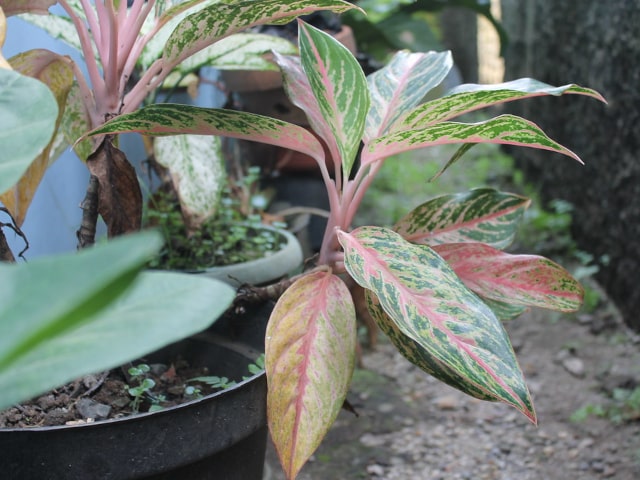
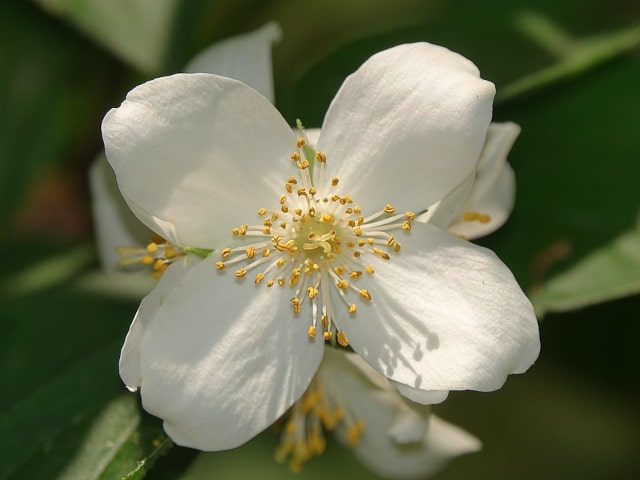
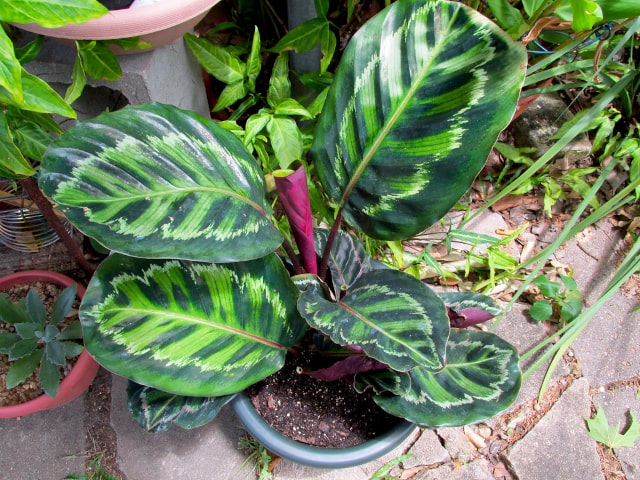
6 Comments
Can you grow them outdoors in Alberta?
My plant is about 20 years old and has only bloomed once. Do I dare hang it outside in the winter? Our temp doesn't get much below 45 F. and I could bring it inside if the temp got down below 50F. I sure would like to see some blooming.
Thank you. I Love the tips and the species list you gave.
We have a Hoya plant from my husband's childhood (50 years back). It was growing in his grandmothers house. His mother got her own very bloomy plant from there. We met and got ours from her 30 years ago. My mother took our plant when we could not take care of it. We get part of the plant back two years ago and now we are trying to identify its species and get it to bloom. Maybe carnosa. We last saw flowers about 25 years ago. Now it is climbing nicely but no flowers, yet.
We are thinking about starting to collect other Hoya species too. So exciting.
How should we cut our Hoya plant back? Where on the plant and when should we do this? Can anyone help me? Thank you
I am looking for wachsblumen. I want to to order it but it wasn't in English so can you help me to find this? The other name on the bottle is flssigdungerkonzentrat, yes this is German not English. I did get this on a Hoyas web site but I cant find the Hoya site where I got it at.
My sister has a Hoya plant that has been several years in a liter container of water and has developed roots galore. She wants to pot it in soil, but will the roots overpower the six leaves, and if so how much should be trimmed. Thanks.